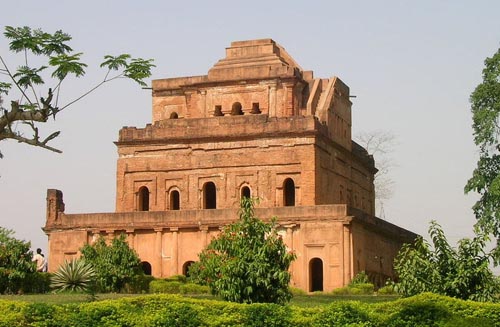Gargaon Palace

Information on Gargaon Palace (Sivasagar, Assam) - History & Architecture
The Gargaon palace also known as the Ahom Raja's Palace is located in the Sivasagar region in the Indian state of Assam. It has a history of more than 250 years associated with it. The place was built under the reign of King Rajeswar Singha of the Ahom kingdom.
Gargaon Palace Architecture
Architecturally, the fort and the palace show the rich skills of the Ahom kingdom. There was a Solang ghar within the palace which was used by the rajas an audience hall to address the people of the kingdom. It was 120 cubits long and a width of 30 cubits. It is known that the entire structure is supported by around 66 pillars. This aspect shows that the palace was quite strong in its own sense. The entire mansion was complete with the use of 12,000 workers which is a record of its own. The palace was completed just within 1 year from where the construction begins. It has also been noted that a major part of the palace has an extensive work of wood carvings and stones. King Rajeswar Singha has a great contribution towards designing the building which further provides the structure an elegant look. Apart from bricks and stones, the construction of the monument also has the extensive use of baked bricks which can also be comprehended by the external look of the monument. There is a garden in front of the palace which makes the entire fort naturally more beautiful and elegant. The construction of the monument does not use any cement rather it implemented eggs and rice paste to make the mortar. This is also an import feature of the fort with regard to its architecture.
Gargaon Palace History
Historically, the Ahom Kingdom was one of most powerful in the Indian state of Assam during their reign. It was during this particular period that the Gargaon palace was made by the King for their personal residence. The foundation stone of the palace was laid in the year 1752 AD under the guidance of King Rajeswar Singha. He was the 15th king of Ahom who ruled over the kingdom of Ahom for a longer period of time. It has been noted that few years after the completion of the fort along with the royal complex of the rajas was badly deteriorated owing to which is had been repaired multiple occasions. It is believed that it was because of the use of weak raw materials that the fort was deteriorated. In the subsequent years, the outer walls of the monument were built by the Rudra Singha who was the son of the ruler i.e. Pramatta Singha. The wall was 5 km in length and it directly lead to the masonry gate of the fort. However, the fort that was built by Rajeswar Singha was made after destroying the previous fort which was in the place from the year 1540 AD.
Gargaon Palace Tourism Importance
With regard to tourism the place is visited by people from all around the world owing. The fact that the monument is well preserved over the years has also contributed towards enhancing its importance amid the tourists. Notably, one can witness the architectural beauty of the Ahom kingdom by visiting the place. The place is open for the visitors daily with the fess being 100 rupees for foreign tourist and 5 rupees for Indian tourist.
- Andaman Nicobar Monuments
- Andhra Pradesh Monuments
- Assam Monuments
- Bihar Monuments
- Chhattisgarh Monuments
- New Delhi Monuments
- Goa Monuments
- Gujarat Monuments
- Haryana Monuments
- Himachal Pradesh Monuments
- Jammu and Kashmir Monuments
- Karnataka Monuments
- Kerala Monuments
- Madhya Pradesh Monuments
- Maharashtra Monuments
- Odisha Monuments
- Punjab Monuments
- Rajasthan Monuments
- Tamil Nadu Monuments
- Telangana Monuments
- Uttar Pradesh Monuments
- West Bengal Monuments